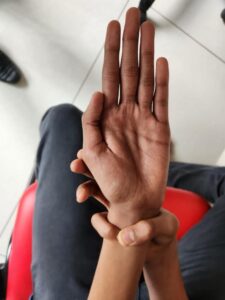Dr Sree Lekshmy.S,Dr.Sheela Namboothiri (Paed genetics), Dr.Mahesh (paed cardiology) DrC Jayakumar
Twelve year old boy, only child of non consangenous parentage presented with complaints of raised chest wall for 2yrs. Vitals were stable and PICCLE was normal.
Auxology:
height-162cm expected149cm
Upper segment(US)-66cm
Lower segment(LS)-96cm
US:LS -0.68expected 1:1
Arm span -173cm
Arm span to height-1.06
Differentials :
Marfan syndrome,
Homocystinuria,
LoeysDietz syndrome.
General examination showed bilateral flared pinna, antimongoloid slant of eyes, retrognathia, hyper elastic fingers, hind foot deformity, mild scoliosis to left.
Thumb and wrist sign was positive.

Steinberg sign (Thumbsign)
Walker Murdoch sign(wrist)
ECHO showed thick myxomatous mitral leaflet with moderate
Myopia and lens no subluxation
WES showed a known heterozygous pathogenic variant in FBN1(exon 39) suggestive of autosomal dominant inheritance of Marfan syndrome.
Family was counselled the prognosis and the need for yearly evaluation for lens subluxation, echo and scoliosis.
Discussion:
Marfan syndrome (MFS)is an inherited multisystem connective tissue disorder.
Incidence is 1 in 10000 with no racial or gender preference.
Inheritance – Most inherited cases showsAutosomal dominant inheritance, with high penetrance but a variable expression. 25% of the cases are sporadic.
Etiopathogenesis – The gene involved in more than 90% of cases is FBN-1 gene on chromosome 15q21. This gene codes for fibrillin 1 protein, an extracellular matrix protein which is an essential component of microfibrils and elastic fibre of connective tissues. Transforming growth factor beta receptor mutation is also seen in some patients.
Clinical manifestations:
Skeletal:
i. Most common is Dolichostenomelia, abnormally long bones especially in limbs compared to trunk. Thus upper segment to lower segment ratio is below -2SD for age and gender and arm span to height is more than 1.05 SD.
ii. Anterior chest deformities like Pectus carinatum (pigeon shaped) or pectus excavatum (funnel shaped)
iii. Spinal deformities: Thoracolumbar scoliosis (Most Common), Kyphosis
iv. Arachnodactyly (abnormally thing long spiderlike fingers)
v. Joint hypermobility, joint contractures
vi. Pes planus or flat feet, Protrusion acetabuli.
Craniofacial: are not consistent and tend to show variability.
i. Dolichocephaly (long narrow skull)
ii. Enophthalmos (deep set eyes), Antimongoloid slant of eyes
iii. Retrognathia (recession of mandible), Micrognathia (small lower jaws)
iv. Malar hypoplasia
CVS
i. Valvular abnormalities: Thickened AV valves, mitral valve prolapse, mitral regurgitation. Aortic aneurysm and aortic regurgitation seen in later life.
ii. Arrythmias: supraventricular arrythmias commonly accompany mitral regurgitation.
iii. Cardiomyopathy, mainly dilated cardiomyopathy.
iv. Aortic dissection- may cause CCF if aortic valve is involved, cause stroke if carotids are involved and acute MI if coronaries are involved.
Ocular:
i. Ectopia lentis (Supratemporal).
ii. Early and severe myopia
iii. Hypoplastic iris
iv. Increased axial length of globe.
v. High risk of cataract, glaucoma and retinal detachment.
Others:
Restrictive lung disease, spontaneous pneumothorax
Skin- striae atrophicae or stretch marks
Inguinal or incisional hernias
Diagnosis: Modified Ghent criteria is used for diagnosis.
MFS can be diagnosed without a positive family history
– Aortic root Z score equal to or more than 2 and Ectopia lentis
– Aortic root Z score equal to or more than 2and FNB-1 mutation.
– Aortic root Z score equal to or more than 2 and systemic score is >7.
In the presence of family history:
-If the patient is having ectopia lentis
-systemic score equal to or more than 7
– Aortic root Z score more than 2 if older than 20yrs or equal to 3 if less than 20.
Management:
Restriction of physical activity
Drugs- beta blockers are the drug of choice to prevent aortic root growth.
Infective endocarditis prophylaxis,
Mitral valve surgery and aortic surgery.
Scoliosis- >20 degree: mechanical bracing and physiotherapy, >45 degree: surgery
Prognosis: Scoliosis once begins is usually progressive. Most of death happen in 30s-40s of age. Most common cause of death is aortic complications. Follow up needs slit lamp examination and ECHO.
